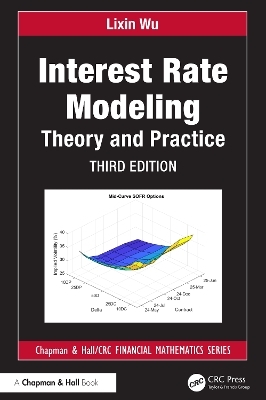
Interest Rate Modeling
Chapman & Hall/CRC (Verlag)
978-1-032-48355-9 (ISBN)
Containing many results that are new, or which exist only in recent research articles, this thoroughly revised third edition of Interest Rate Modeling: Theory and Practice, Third Edition portrays the theory of interest rate modeling as a three-dimensional object of finance, mathematics, and computation. It introduces all models with financial-economical justifications, develops options along the martingale approach, and handles option evaluations with precise numerical methods.
Features
Presents a complete cycle of model construction and applications, showing readers how to build and use models
Provides a systematic treatment of intriguing industrial issues, such as volatility smiles and correlation adjustments
Contains exercise sets and a number of examples, with many based on real market data
Includes comments on cutting-edge research, such as volatility-smile, positive interest-rate models, and convexity adjustment
New to the Third edition
Introduction of Fed fund market and Fed fund futures
Replacement of the forward-looking USD LIBOR by the backward-looking SOFR term rates in the market model, and the deletion of dual-curve market model developed especially for the post-crisis derivatives markets
New chapters on LIBOR Transition and SOFR Derivatives Markets
Lixin Wu earned his PhD in applied mathematics from UCLA in 1991. Originally a specialist in numerical analysis, he switched his area of focus to financial mathematics in 1996. Since then, he has made notable contributions to the area. He co-developed the PDE model for soft barrier options and the finitestate Markov chain model for credit contagion. He is, perhaps, best known in the financial engineering community for a series of works on market models, including an optimal calibration methodology for the standard market model, a market model with square-root volatility, a market model for credit derivatives, a market model for in inflation derivatives, and a dual-curve SABR market model for post-crisis derivatives markets. He also has made valuable contributions to the topic of xVA. Over the years, Dr. Wu has been a consultant for financial institutions and a lecturer for Risk Euromoney and Marco Evans, two professional education agencies. He is currently a full professor at the Hong Kong University of Science and Technology.
1. The Basics of Stochastic Calculus. 1.1. Brownian Motions. 1.2. Stochastic Integrals. 1.3. Stochastic Differentials and Ito's Lemma. 1.4. Multi-Factor Extensions. 1.5. Martingales. 1.6. Feynman-Kac Theorem. 2. The Martingale Representation Theorem. 2.1. Changing Measures with Binomial Models. 2.2. Change of Measures under Brownian Filtration. 2.3. The Martingale Representation Theorem. 2.4. A Complete Market with Two Securities. 2.5. Replicating and Pricing of Contingent Claims. 2.6. Multi-Factor Extensions. 2.7. A Complete Market with Multiple Securities. 2.8. Notes. 3. U.S. Fixed-Income Markets. 3.1. The U.S. Federal Fund Market. 3.2. The U.S. Bond Markets. 3.3. Bond Mathematics. 3.4. Discount Curve and Zero-Coupon Yields. 3.5. Yield-Based Bond Risk Management. 3.6. The Interbank Lending Market. 3.7. The LIBOR Market. 3.8. Repurchasing Agreement. 4. LIBOR Transition and SOFR Derivatives Markets. 4.1. LIBOR Scandal and the Cessation of LIBOR. 4.2. SOFR. 4.3. Transition to Risk-Free Overnight Rates and LIBOR Fallbacks. 4.4. Linear Derivatives Based on the Risk-Free Rates. 4.5. Nonlinear Derivatives Based on the Risk-Free Rates. 5. Forward Measures and the Black Formula. 5.1. Lognormal Model: The Starting Point. 5.2. Forward Prices. 5.3. Forward Measure. 5.4. Black's Formula for Call and Put Options. 5.5. Numeraires and Change of Measures. 5.6. Futures Price and Futures Rate. 6. The Heath-Jarrow-Morton Model. 6.1. The HJM Model. 6.2. Estimating the HJM Model from Yield Data. 6.3. An Example of a Two-Factor Model. 6.4. Monte Carlo Implementations. 6.5. Special Cases of the HJM Model. 6.6. Linear Gaussian Models. 6.7. Pricing SOFR Derivatives under HJM Model. 6.8. Notes. 7. Short-Rate Models and Lattice Implementation. 7.1. From Short-Rate Models to Forward-Rate Models. 7.2. General Markovian Models. 7.3. Binomial Trees of Interest Rates. 7.4. A General Tree-Building Procedure. 8. Affine Term Structure Models. 8.1. An Exposition with One-Factor Models. 8.2. Analytical Solution of Riccarti Equations. 8.3. Pricing Options on Coupon Bonds. 8.4. Distributional Properties of Square-Root Processes. 8.5. Multi-Factor Models. 8.6. Pricing SOFR Futures under ATSMs. 8.7. Swaption Pricing under ATSMs. 8.8. Notes. 9. Market Model for SOFR Derivatives. 9.1. Market Model with SOFR Forward Term Rates. 9.2. Construction of the Initial Forward Rate Curve. 9.3. Monte Carlo Simulation Method. 9.4. Volatility Smiles and the Direct Adaptation of Smile Models. 10. Convexity Adjustments. 10.1. Pricing through Adjustments. 10.2. Quanto Derivatives. 11. Market Models with Stochastic Volatilities. 11.1. SABR Model. 11.2. Wu and Zhang Model. 11.3. Appendix: Derivation of the HKLW Formula. 11.4. Appendix: Proof of Proposition. 12. Lévy Market Model. 12.1. Introduction to Lévy Processes. 12.2. Lévy-HJM Model. 12.3. Market Model under Lévy Processes. 13. Market Model for Inflation Derivatives. 13.1. CPI Index and Inflation Derivatives Market. 13.2. Rebuilt Market Model and the New Paradigm. 13.3. Pricing Inflation Derivatives. 13.4. Model Calibration. 13.5. Smile Modeling. 14. Market Model for Credit Derivatives. 14.1. Pricing of Risky Bonds: A New Perspective. 14.2. Forward Spreads. 14.3. Two Kinds of Default Protection Swaps. 14.4. Par CDS Rates. 14.5. Implied Survival Curve and Recovery-Rate Curve. 14.6. Black's Formula for Credit Default Swaptions. 14.7. Market Model with Forward Hazard Rates. 14.8. Pricing of CDO Tranches under the Market Model. 14.9. Notes. 15. xVA: Definition, Evaluation, and Risk Management. 15.1. Pricing through Bilateral Replications. 15.2. The Rise of Other xVA. 15.3. Examples. 15.4. Notes.
| Erscheinungsdatum | 10.07.2024 |
|---|---|
| Reihe/Serie | Chapman and Hall/CRC Financial Mathematics Series |
| Zusatzinfo | 25 Tables, black and white; 77 Line drawings, black and white; 77 Illustrations, black and white |
| Sprache | englisch |
| Maße | 156 x 234 mm |
| Gewicht | 970 g |
| Themenwelt | Mathematik / Informatik ► Mathematik ► Angewandte Mathematik |
| Wirtschaft ► Betriebswirtschaft / Management ► Finanzierung | |
| Wirtschaft ► Volkswirtschaftslehre ► Ökonometrie | |
| ISBN-10 | 1-032-48355-5 / 1032483555 |
| ISBN-13 | 978-1-032-48355-9 / 9781032483559 |
| Zustand | Neuware |
| Haben Sie eine Frage zum Produkt? |
aus dem Bereich


